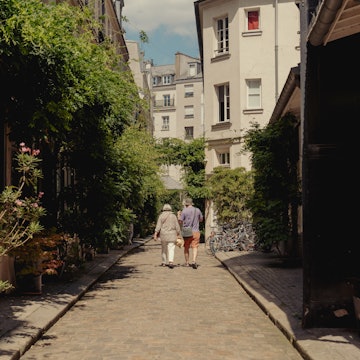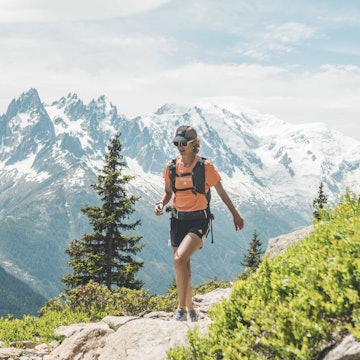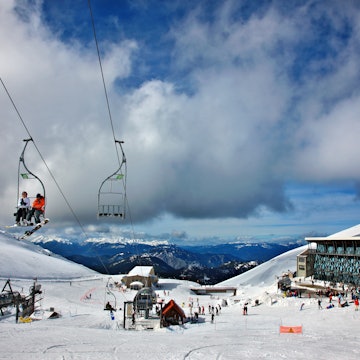

Skiers beginning the descent of the Vallée Blanche, French Alps. Roberto Caucino/Shutterstock
In the French Alps, beauty of the most breathtaking nature and heart-stopping action collide. Glacier-carved national parks and shark-toothed mountain summits, ice-blue lakes and sky-high cols (mountain passes): the call of the wild is fierce in this eastern swath of France, even more so for anyone who loves thrilling cold-weather adventures.
It would take years of visits to see all that this mountainous region has to reveal – rugged (if sadly shrinking) glaciers, fresh-from-the-farm cheese in remote villages, ever-changing vistas of cloud-wrapped peaks, and much more. Yet since first-time visitors have to start somewhere, this introduction to the French Alps homes on a few of the heaviest high-altitude cold-weather hitters.
Our short but packed itinerary combines time on the slopes in Chamonix with a glacial trip of a lifetime by cable car up to the Aiguille de Midi, then down the Vallée Blanche (again, on skis). Pair a day ski touring or snowshoeing in Valloricine with an unforgettable alpine lunch.
Here’s how to sample the winter delights of the French Alps in just three days.
When to arrive in the French Alps
The ski season in the French Alps kicks off in mid-December and usually runs through April. In January, you can expect cold days with below-freezing temperatures, bitter winds and snow at all altitudes; if you’re driving, winter or all-season tires are essential. School holidays mean sky-high prices and packed pistes at ski resorts in February and March. As the season rolls along, long sunny days meet heavy spring snow and fun, end-of-season ski races and parties. By the end of April, most resorts shut.

How to get around in the French Alps
In Chamonix, the many ski areas are famously not linked by pistes, and getting from one to another involves land transport. Buses in town and the Vallée de Chamonix (from Argentière or Col des Montets to Servoz and Les Houches) are free with a Carte d’Hôte (Guest Card) – get one free at your hotel or B&B. The same card will cover your ride on the northbound Mont Blanc Express train, which trundles through Alpine valleys on its way to Switzerland.
If a camper van is your dream means of cruising around this handsome neck of the woods, pick up van and itinerary from Dreamer Van in Chamonix.
What to pack for the French Alps
Layers, layers and layers. Whether you’ll be skiing all day or not, you’ll want to wear a moisture-wicking base layer at all times, along with a fleece or other intermediate layer, followed by a ski jacket or other windproof outer layer. How you wish to accessorize from there – whether with ski goggles, plush cashmere scarf or fur hat – is a matter of how much you plan hit the slopes, and/or how much you plan to hit the après-ski scene.

Day 1: Hit the slopes – and the après scene – in Chamonix
Morning and afternoon: Springboard to some of Europe’s most fêted mountain adventures, Chamonix, loomed over by majestic Mont Blanc, has always been one ski spin ahead of the curve. Several ski areas surround the bustling hub of the French Alps, with slopes to suit comers of all skill levels. Spending a day sampling them is as good an introduction to these mountains as you’ll find.
On the less-intense end of the ski spectrum, Les Houches draws families, while La Flégère has runs suitable for beginners and intermediate skiers.
Yet it’s expert skiers who arguably love Chamonix most. Freeriders after big lines head to the steep, challenging slopes, moguls and gnarly powder of the Grands Montets ski area in Argentière, and to white-knuckle blacks in Les Houches; the vertical Kandahar on the Verte des Houches piste is legendary. The sunny slopes of Brévent-Flégère are also excellent for advanced skiers.
Evening: After a day of runs, sample Chamonix’ sizzling après-ski scene. “Walk in, dance out” is the motto at Moö, by Chamonix’ train station on bar-busy ave Michel Croz. The classic first-port-of-call after the slopes, this Swedish-run bar rocks starting at 4pm. Across the street at Chambre Neuf, après-skiers slam plastic glasses of Stella, dance on tables and empty out the bar by 8:30pm, when the live music ends.
Later, move on to Folie Douce, popular with an older set, then Amnesia Club – Chamonix’ biggest nightclub and notorious party-animal temple.

Day 2: Ascend the Aiguille du Midi, then descend via the Vallée Blanche
Morning: The Aiguille du Midi is the rocky tooth (aiguille means needle in French) of a 3842m peak in the Massif du Mont Blanc, and hosts France’s highest cable-car station at 3777m. Set up and off on the Téléphérique de l’Aiguille du Midi to its top station, at a dizzying 3842m – stopping midway at Plan d’Aiguille du Midi (2317m) for a nerve-steadying coffee or vin chaud (hot wine), with a side of panoramic views of the many other aiguilles that sculpt Chamonix’ distinctive skyline.
Even James Bond would have a field day at the futuristic top station, inconceivably entwined around Aiguille du Midi’s imposing burnt-orange granite summit. Dank, dimly lit tunnels spaghetti from the cable car to a succession of outdoor panoramic terraces.
Follow signs to Le Tube, a 34m-long metal pipe wrapped around part of the rocky spur. Take your time to traverse the cylindrical walkway, perforated with five slit windows. Then ride the lift up to Pas dans le Vide, a glass-walled and -floored cabin overhanging a 1000m drop which at 3830m rests just 12m short of the summit. The views down are predictably exhilarating or terrifying – depending on your head for heights.
Afternoon: Dangerous and thrilling, the Vallée Blanche is Europe’s most legendary off-piste ski route – and accordingly one that must be tackled with a guide. This 2800m descent from the Aiguille du Midi cable car station traverses a landscape of eerie, unearthly beauty. The 20km route follows three serpentine glaciers down to the Mer de Glace glacier. Ride the cable car to Gare de Montenvers, then take the cherry-red cog train back down to Chamonix.
Late March and early April is the best time to tackle the Vallée Blanche, which is only suitable for confident skiers comfortable on ungroomed terrain. Hook up with a guide from Compagnie des Guides de Chamonix on a small-group expedition (145 euros per person, plus lift passes).

Day 3: Country pleasures (and more snow sports) in Valllorcine
Morning: Continue on the Mont Blanc Express to the village of Vallorcine, just 2km from the Swiss border: after the rush of action-packed Chamonix, the slower pace of rural village life will be a breath of fresh air. It’s impossible to say what’s most alluring here: shopping for organic Tomme de Savoie and creamy sérac cheese at La Ferme de Vallorcine; scoffing glorious puddles of gooey raclette on the sun-bathed terrace of Le Café Comptoir; or taking a moment to reflect at the 13th-century Église Notre Dame de l’Assomption, which was rebuilt in 1755 after several avalanches and recently outfitted with contemporary stained glass by South Korean artist Kim En Joong.
Afternoon: On the riverbanks of L’Eau Noire, a cable car whisks winter skiers up to 21 gentle blue and red runs in the refreshingly unchallenging Domaine de Balme–Le Tour ski area. Beautiful views – of the entire Chamonix Valley below and Swiss Alps to the north – give slower-paced snowshoeing and ski touring extra appeal. Skiers hungry for something new can dabble in speed-riding with a mini-sail in the open bowl of slopes here. If it’s cheese and tranquility you’re seeking, the steep, two-hour skin up to Refuge de Loriaz (2020m) for lunch is a delightful ski-touring secret that few locals like to share. But we just did.
This article was adapted from Lonely Planet’s France guidebook, published in May 2024.
















